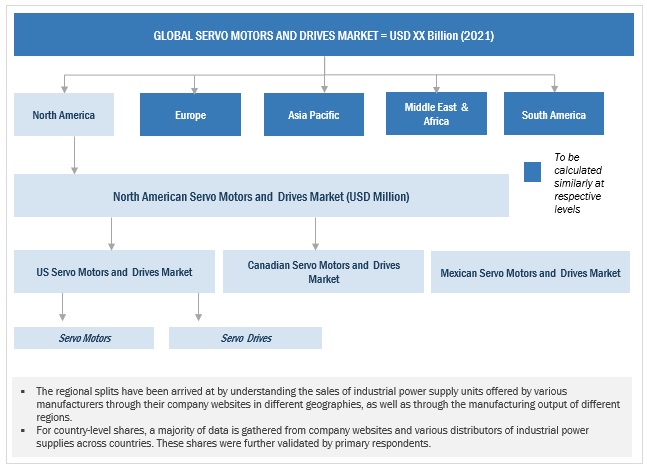Global Servo Motors and Drives Market Scenario
The servo motors and drives industry is currently experiencing a noticeable trend toward greater integration of modern technologies to improve performance and efficiency. Industry 4.0 and the Industrial Internet of Things (IIoT) are driving a move toward smarter, networked systems that require precision control and real-time responsiveness, resulting in increased adoption of servo motors and drives. Furthermore, there is an increasing emphasis on energy efficiency, with manufacturers looking for environmentally friendly solutions. The market is also seeing a shift toward downsizing and lightweight design to fulfill the needs of compact and portable applications. As automation spreads across industries, the servo motors and drives market size is expected to develop, driven by the demand for greater motion control in modern, high-tech manufacturing processes.
According to a new market research report “global Servo motors and drives market is expected to rise to USD 15.8 billion by 2027, up from USD 12.0 billion in 2022, at a CAGR of 5.7% over the forecast period.”
Servo Motors and Drives Market Demand Side Analysis
Demand-side analysis of the servo motors and drives market trends entails investigating the factors that influence the consumption and procurement of these important components in the industrial and automation industries. As industries prioritize precision, efficiency, and flexibility in their operations, the need for servo motors and drives has increased dramatically. The increasing use of automation in industrial processes, robotics, and other industries has been a major motivator. Furthermore, technological improvements, such as the integration of IoT and Industry 4.0, have increased demand for intelligent and sensitive motion control systems. Industries seeking more productivity, lower energy consumption, and greater accuracy in their machines contribute considerably to the growing need for servo motors and drives. Economic considerations, legal changes, and altering client preferences all play important roles.
Download PDF Brochure: https://www.marketsandmarkets.com/pdfdownloadNew.asp?id=1127
Global Servo motors and drives Market Size: Top-down Approach

Key Market Players
The leading players in the global servo motors and drives market include Yaskawa Electric (Japan), Siemens AG (Germany), Mitsubishi Electric (Japan), Schneider Electric (France), Rockwell Automation (US), and ABB (Switzerland).
Yaskawa Electric is one of the leading manufacturers in the fields of drive technology, industrial automation, and robotics in Japan. Yaskawa has been ensuring to provide cutting-edge technologies in its products and services. The servo motors and drives of the company are offered under its Motion Control segment. The demand for these products offered by the company is due to their better-performing motors and drives, which are contributing to energy-saving and optimized operational control.
Mitsubishi Electric is one of the leaders in the manufacture and sales of electric and electronic equipment for various applications. The company offers its servo motors and drives under its Industrial Automation Systems segment. The company has been implementing innovations in this automation field creating the highest segmental revenue in the company’s business.
Europe is expected to be the second largest segment in the global servo motors and drives market during the forecast period
The servo motors and drives market in Several European countries align their manufacturing processes with the International Electrotechnical Commission (IEC) standards. The IEC develops international standards for adoption by companies in the field of electrotechnology. These standards ensure that the companies adopt such ways of manufacturing, which lead to the electrical energy optimization of their manufacturing processes. Energy-efficient servo motors and drives ensure that these companies pertain to IEC standards. The role of servo motors and drives in various advanced process control systems and robots to facilitate factory automation has been widely recognized throughout Europe in electronics, automotive, semiconductor, and other industries. Furthermore, various developments in the automotive industry, such as autonomous vehicles, hybrid vehicles, and unmanned ground vehicles (UGV), are expected to increase the demand for servo motors and drives.
Request Sample Pages: https://www.marketsandmarkets.com/requestsampleNew.asp?id=1127
Objectives of the Study
- To define, describe, segment, and forecast the servo motors and drives market size based on offering, product type, voltages, system type, brake technology, communication type, materials of construction, end-user
- To provide detailed information on the major drivers, restraints, opportunities, and industry-specific challenges influencing the growth of the servo motors and drives market
- To strategically analyze the servo motors and drives market with respect to individual growth trends, prospects, and contributions of each segment to the market
- To analyze market opportunities for stakeholders and provide a detailed competitive landscape for market leaders
- To forecast the revenue of the market segments with respect to 5 main regions (along with countries), namely, North America, Europe, Asia Pacific, South America, and the Middle East & Africa
- To strategically profile key players and comprehensively analyze their market ranking and core competencies
- To track and analyze competitive developments such as new product developments, contracts & agreements, investments & expansions, and mergers & acquisitions in the servo motors and drives market

